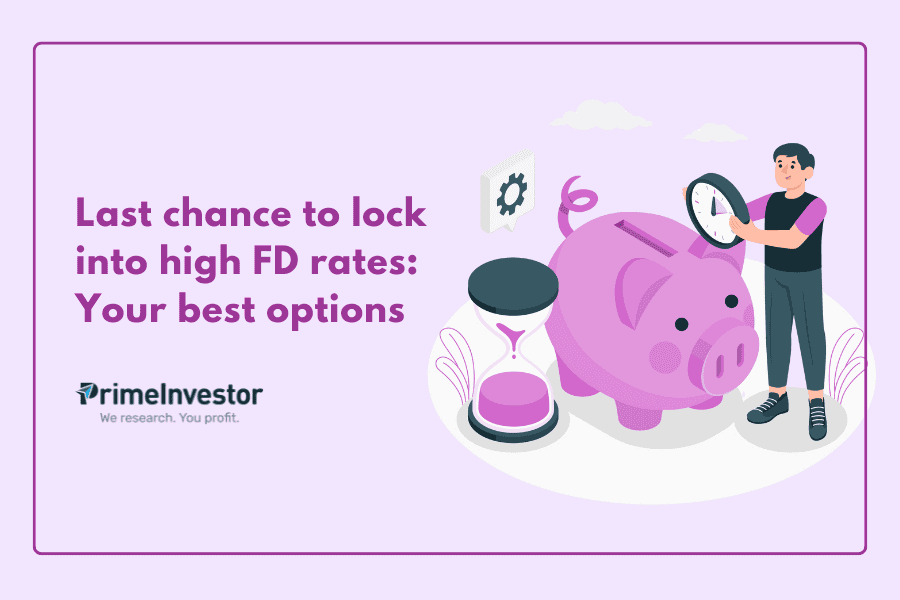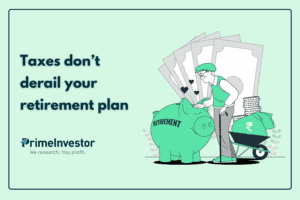After staying elevated for a year from December 2023 to January 2025, interest rates on fixed deposits are beginning to decline. Both banks and NBFCs have begun to trim their deposit rates. This could be the beginning of a material downturn in interest rates where deposit rates fall by 100 basis points or more. Therefore, this may be the last window of opportunity for fixed deposit investors to lock into high rates. Locking into 4 to 5-year deposits today can protect your returns from reinvestment risks, until the rate cycle turns up again.

Triggers for the fall
Bank FD rates are a function of the rates at which banks get to borrow from the RBI and markets, the availability of funds in the market and competition for deposits. Currently, two of the three factors support a cut in deposit rates.
- Policy rate cuts: Banks usually borrow money from RBI through the repo window and avenues such as the Marginal Standing Facility. Interest rates on these borrowings are decided by the Monetary Policy Committee (MPC) which meets on a bi-monthly basis. The repo rate, which stayed at 6.5% between March 2023 and January 2025, has been cut by 50 basis points to 6% in the last two meetings. The Marginal Standing Facility rate is also down by 50 basis points to 6.25%. This is a signal for banks to cut both lending and deposit rates. With the MPC prioritizing growth and recent inflation readings dipping below 4%, RBI is expected to cut rates by another 50 basis points in this cycle, as we wrote here.
- Lending rates heading down: To preserve their margins, banks need to make sure that their deposit rates are re-adjusted downwards when lending rates fall. Today, compared to a few years ago, a sizeable portion of bank loans to retail customers are pegged to repo rates. They automatically adjust to repo rate changes. As the rates on repo-linked loans fall, banks are forced to trim their deposit rates too. RBI data suggests that this is beginning to happen. The Weighted Average Lending Rate for commercial banks’ outstanding loans, which had stayed at 9.86-9.89% between June and December 2024, dipped to 9.78% in February 2025. While the Weighted Average Deposit Rate on banks’ legacy deposits has held steady at 7.02%, the rate on new deposits has begun to fall, sliding from 6.57% in December to 6.48% in February.
- Liquidity situation eases: A tight liquidity situation in money markets had led to banks scrambling for funds until January. However, RBI has lately been pumping substantial liquidity into the markets through open market operations and other means. This has made more funds available to the banking system and moderated short-term borrowing rates in the market. RBI data shows that the weighted average call money rate and market repo rate were hovering at 6.74% in December 2024 but were down to 5.8-6% by 22 April 2025, a 70-80 basis points fall. This is likely to have reduced banks’ cost of funds.
The cuts have begun
Deposit rate cuts usually begin with the largest banks and then percolate To NBFCs. On April 15, SBI announced a token 10 basis point cut in its FDs for 1 to 3-year tenures to below 6.9%. On April 19, HDFC Bank announced deeper cuts of upto 50 basis points in its 1 to 3-year FDs, which now earn 6.7-7.05%. Riskier private banks such as Yes Bank and Bandhan Bank have also trimmed FD rates.
Deposit rates offered by NBFCs are not directly linked to repo rates. But as NBFCs source their funds either from banks or the bond market, falling short-term rates and bank lending rates reduce borrowing costs for NBFCs. Therefore, NBFC deposit rates tend to follow the trend in bank FD rates. While most NBFCs have not reduced rates yet, Bajaj Finance has trimmed its FD rates by 25 basis points recently.
Lock into longer tenors
This may therefore be your last chance to lock into higher FD rates in this rate cycle. Rate cycles in India usually last 4-5 years.
While choosing FDs for investment today, it makes sense to lock into FDs for 4-5 year tenors, rather than opting for shorter tenors even if the rates seem more attractive for shorter tenors. Most banks and NBFCs would like to lure you into the 1 to 2-year buckets currently by offering high rates in these buckets.
But investing in 1-to 2-year FDs will subject your deposit money to reinvestment risks, as rates may fall by 50-75 basis points from here forcing you to settle for lower rates on renewal.
To illustrate, investing Rs 10,000 into a 5-year FD at an annualized rate of 7.9% today would get you to Rs 14625 at the end of 5 years. Investing in a 2-year FD at 8.3% and reinvesting at 7.5% for the remaining three years (assuming FD rates fall to 7.5% after two years) would get you to just Rs 14570. This is the impact of reinvestment risk.
On skimming through interest rates offered by banks and NBFCs, we found that banks do not offer competitive rates for 4 to 5-year tenors.
AAA-rated NBFCs offer attractive rates for FDs with 4 to 5-year tenors. We recommend the following long-tenor FDs for individuals below 60 years of age. Do note that NBFC FDs do not carry deposit insurance like banks. Therefore, investors are advised to diversify across entities and park only their surpluses (and not emergency or essential funds) in them.
For senior citizens, the post office Senior Citizens Savings Scheme should remain the top choice given its high rates backed by sovereign guarantee. As these rates could get revised downwards next quarter, investors should lock in for 5 years before June 30, 2025. Folks who have exhausted the Rs 30 lakh limit on SCSS, can consider the other NBFC FDs mentioned below.
Shorter tenors
If you have surpluses to spare only for shorter tenors, what should you do? Well, if you are looking for FDs to park your emergency or essential money, we recommend only the leading banks. Among the established large banks, Kotak Mahindra Bank and ICICI Bank offer relatively better rates and can be considered. Kotak Bank offers 7.65% for seniors and 7.15% for others on 23-month FDs. ICICI Bank offers 7.55% for seniors and 7.05% for others on 18 to 24-month FDs.
While small finance banks offer higher rates of 8% plus, they do not offer sufficiently high rates for the risks taken, given that they lend mainly to small-ticket borrowers who have shown some signs of distress in the past year. The Rs 5 lakh deposit insurance cover seems to be prompting SFBs to offer lower rates than is merited by their lending profile. We believe that short-tenor bonds from AAA-rated NBFCs offer a better alternative, if you are willing to take on higher risks for debt returns. Watch out for our bond recommendations in Prime Bonds.





13 thoughts on “Last chance to lock into high FD rates: Your best options”
Thank You for a details article . Many such articles are very useful . Requesting an article on Retirement Corpus investing for retiree. Now a days more focus is given on asset allocation , rebalancing , multi asset investment etc. Primes 7 Yr plus investments advocates certain portion in debt and certain portion in equity. However, when one rebalances the portfolio , due to tax implication (over a long period) good amount goes in taxes. In such a case, should one use Hybrid Funds matching the time horizon like 5 Yrs in debt, 5 to 10 in Conservative Funds, Above 10 in BAF or Multi Asset etc I am not sure . Requesting such an analysis from Prime Investor team. Thanks for doing a great and best Job.
Thank you so much. I will definitely write on this topic. It is true that rebalancing is an issue, will address this.
How is Shriram Finance Ltd – Fixed Deposits?
They recently had a rating upgrade too, decent fundamentals, listed.
Senior Citizen long term FD rates are 9.3% plus 0.1% for all women depositors.
No reported NPAs in past 3 years.
From share perspective:
Return on Equity has increased versus last 3 years average to 18.00%
Total Income has increased 27.82 CAGR in last 3 years
Net Profit has increased 25.67 CAGR in last 3 years
they have been in FDs for over 10-15 yrs.. and good track record.
While Shriram is an established group with a long track record of FD servicing, the lending business of the group is riskier than the other players. We prefer a low risk approach to FDs as the upside in returns for taking additional risk is not high. We have recommended bonds with better yields
Was expecting the riskier response.. hence had shared facts on their business performance. Rechecking isn’t it convincing enough if you see they have survived 2008, COVID.. risky business, but perhaps very well managed?
Possible to revisit this?
Also the RBI 5L insurance limit applies to NBFC FDs top?
Only banks have deposit insurance. NBFC deposits are unsecured and have no insurance cover. Risk taking is an individual decision sir. Our stance has always been that risk taking is best done in equities where upside is high rather than FDs where reward for risking capital is very low.
Thank you Aarati.
In this respect, what is your view for investment in short term or medium term debt MF. The list of Prime funds still show some yield up to 9 and 9.3%. This will be affected by the rate cut but to the extent to cut by Banks, because in my opinion the banks keep the spread while lending, which according to me will be higher than lending for CP etc. Please give your views.
View Fds as income generating options and debt funds as part of asset allocation. We have alreadygiven our call on debt funds recently. Please check the Articles section. Vidya
Would it be correct to say that someone in their accumulation phase does not require an FD besides may be for the emergency fund? They don’t need their corpus to generate an income as the salary/business or professional income covers their expenses. Hence no role for an FD?
Yes FDs are mainly for emergency money or income
Hi Vidya
Can you elaborate on the distinction you make here in terms of asset allocation vs income generation? For an average investor, both offers near equal returns and low risk. Why should FDs not be part of asset allocation for the debt portion?
Secondly, I remember Equitas FDs as one of the suggestions made by PI earlier. I take your point that there’s deterioration in the MFI book. Do you think I should hold on to those FDs and book out and reinvest elsewhere? My 40% debt is in FDs in Equitas as I am using this as my debt allocation. Remaining 60% in equities. I have slowly started in debt funds now as I burnt my fingers earlier in Franklin UST fund fiasco.
If you use cumulative FDs which compound, they can be part of your debt allocation. But taxation wise debt funds are better as they defer tax payments until maturity. While Equitas is a good bank, it is a risky lender and should not be 40% of your debt allocation, it makes sense to limit your FDs in it to Rs 5 lakh the deposit insurance limit.